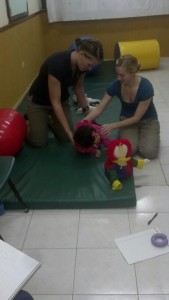By Gillian Givens.

Health care professionals have an unprecedented ability to prompt change in the patients and families with which they interact. Professionals within the healthcare realm are extremely influential in critical life changing experiences. It is crucial to understand that you, as a health care professional, are many times viewed as a source of hope and positivity by many individuals that are affected by a single, sometimes devastating, event. A certain diagnosis carries with it a multi-factorial series of implications in both the experience of the individual patient and the lives the patient will effect in the present and future.You have the ability to empower healthy change in your patients and all of the people that they will touch in their lifespan. Imagine being able to affect at least double the number of individuals that you interact with simply by acting as a catalyst for healthy change in your patients.
While the patient has been mentioned many times, the core of proper holistic care takes root in the attitudes and biases of the professionals that they interact with. The root of the issue with subpar health care lies in the nurse or physical therapist treating the patient, NOT the response of the patient themselves. While this idea may seem strange, I would like you to consider a realistic scenario that I have personally experienced many times while on clinical rotations: a health care professional with a negative attitude that always seems to be complaining, yet becomes frustrated with a patient because they are not “compliant” with treatment and considered to be difficult. From an observational standpoint, how can we as health care professionals expect our patients to demonstrate the commitment and enthusiasm that is necessary for them to evoke positive change and healing, while we ourselves are being negative and critical? The basis of that interaction is completely unfair to the patient and does not uphold excellent patient care. However, it is not to say that some patients are more difficult to reach because of barriers like dementia and Alzheimer’s, but it is critical to radiate healing energy regardless of the medical diagnosis. Health care professionals are healers. We must work hard to first heal ourselves before we expect our patients to heal themselves. I would like to outline some areas of focus to begin this journey of self discovery, to better heal yourself and those that you are helping to heal.
1.) Self-awareness
To begin this process, the practice of self-awareness must be at the forefront of initiating the process of self-healing. By becoming more self-aware, you are able to share these tools with your patients, and promote their internal healing processes. Self-awareness is oftentimes linked to awareness of the corporal self, how we move through space and get into our car and drive to work. However, it is imperative to realize that while the physical body is an element of our self definition, the energy and words/actions that we choose to release into our environment are extremely important. With every word and action you articulate and execute, you have the ability to either create negative or positive change.
While to some a few words may not seem to make a huge difference, I beg to differ. Imagine saying a few words to a critically ill patient such as “you will never get better”. Imagine the impact that those five words have just imposed on a patient that has been struggling with depression and anxiety while in the hospital. You alone, have now become a central stimulant to begin a process that feeds into the negativity that is already taking place. Choose your words and actions wisely, your patients and their families are looking to you as a source of support and positive change.
Working in a health care environment can oftentimes be daunting and stressful, there are no illusions with this truth. Practicing self-awareness in an environment like this takes practice and effort which is sometimes difficult, especially when exhausted. Taking an internal scan of how you are feeling and reacting to your environment is especially critical during times like these. If you feel that you’re absorbing negativity from the environment, change your thinking. YOU alone have the perspective and self-awareness to dictate how you respond to situations, not your environment or your patients. Self-awareness requires commitment and discipline, but I can guarantee that once you become aware of the effect you have on others, you will be better able to truly listen and connect with patients in a way that allows a deeper, more meaningful healing interaction.
Tips:
-
Quick meditation to center yourself.
-
Awareness of your breath to refocus yourself.
-
Focus on the goal, not the distractions.
-
Journal
-
Learn from your patients: learn something from them that stimulates positive change in you.
2.) Healthy Empathy
The complexity and range of emotions that occur with patient care is inevitable. There will always be complications, tragedies and human suffering no matter the environment. This also is an universal truth, and is a shared human experience that comes in many forms but share a common basis. Being able to provide the empathy that patients require, while not internally storing it, is crucial to ensure excellent patient care and to avoid becoming “burned out”. I learned this lesson very quickly while rotating in the Intensive Care Unit. In the beginning of this rotation, it was extremely difficult for me to interact with patients/families that were experiencing so much loss and not “take it home with me”, so to speak. I found myself leaving the hospital drained and sad, and in the process demoralized to a point where I was sure that my patient care was suffering. I felt emotionally exhausted and though I was grateful for these experiences putting my life into perspective, I had to develop coping mechanisms that were respectful to myself and to my patients. Witnessing the balance of life and death every day, pushed me to approach empathy in a way that was healthy and productive instead of being a source of depletion.
Empathy involves the ability to “feel” for another human experience and to also recognize it as being legitimate. There are ways to perform both of these actions while being able to preserve the core emotional homeostasis that you require for your own well-being. I learned very quickly to differentiate between peripheral and core empathy: peripheral empathy acknowledges and participates in the shared human experience of loss and joy without necessarily internalizing it. Core empathy is choosing to internally store components of an experience in a way that helps to promote self growth. There is choice with empathy; make choices that create internal change in a healthy way, and avoid choices that cause emotional instability. Imagine the peaks and valleys of human experiences that occur in one standard day in a hospital setting: a baby being born, a beloved matriarch passing; to personally absorb each and every one of these experiences completely disrupts your emotional center. Lacking emotional resiliency results in unreliable patient care. Maintaining a perspective of emotional balance is integral for yourself and your patients.
Tips:
-
Realize that suffering/grief is a natural part of the human experience and choose when to internalize it.
-
Journal difficult experiences and think about what can be gained from them- internalize if it creates positive change.
-
Encourage your patients to be grateful, remind them of blessings.
-
Participate in an activity after work that can be enjoyed separately from the stressful environment: create your own oasis.
3.) Welcoming Change with a Compassionate focus
Change is another reality of health care that will always be constant. The evolution of a patient’s journey from sickness to healing involves a long chain of remodeling. From my experience, change is not always welcomed because it is mysterious and presents an element of the unknown. Both therapist and patient experience this element of mystery; whether it be dealing with a new diagnosis, a tricky family situation, or a sudden change in the patient’s medical experience. Rather than being intimidated by this dilemma, use this experience as a platform to focus change within a patient-oriented, compassionate scope. Encourage family members and friends to participate in welcoming this change. Ask your colleagues and other members of the patient’s medical team to accept situations that may seem like drawbacks, as being a necessary and positive transformational step in the journey of the patient.
As a student in physical therapy, I have often been at the forefront of trying to instill positive, healthy changes in my patients. This role in care makes me an agent of change. The fact that we as healthcare providers, encourage change in our patients’ lives, also means that we ourselves need to be willing to accept change. I believe that most individuals would consider themselves to be dynamic beings; if this is true, then why would we limit ourselves to static experiences that don’t allow us to reinvent ourselves? Change should be viewed as a chance to grow and explore. Always be thankful for it, and realize that it seldom presents itself in the form that you desire but facilitates the growth that you require. If you communicate that willingness and acceptance of change with your patients, they will be more willing to accept and hopefully encourage others to view change the same way. We live in a society that values instant gratification. Realize that change is a process that takes time, patience, and commitment. I often find myself hoping to create dramatic change instantly both in myself and my patients, and not respecting the beauty of the process that it encourages. In Deepak Chopra’s book Reinventing the Body, Resurrecting the Soul, he outlines a concept known as subtle action which involves the healthy approach to change that is necessary:
1.) You go inside and make your intention known.
2.) You believe in getting results.
3.) You don’t resist the process of change.
4.) Your body shifts effortlessly at the physical level.
5.) You repeat your subtle action until you have mastered the change you desire.
The beauty of this process is its’ simplicity; it doesn’t involve processes that exhaust and overextend you, thereby making change seem impossible. Adopt this attitude and follow these steps to encourage this behavior in your patients. Teach them the skills of self-awareness and compassionate thinking that you have mastered, so that they may master a healthy approach to their experiences and encourage this growth in others.
Tips:
-
Use the process of subtle action.
-
Emphasize change in a compassionate spectrum by involving everyone you can. Gain fresh perspectives.
-
Accept that change is natural and should be welcomed as part of the human experience.
-
Re-assess your inner motivation and believe that the opportunities/experiences you need will be present to you without struggle.
-
Encourage change as a positive concept in patient care.
-
Get rid of your comfort zone; reinvent yourself.
-
Rid yourself of your own biases: engage the patient, not your perception of them.
-
Consider yourself and your patient as dynamic beings; share all elements of human experience.
-
Stop thinking about yourself, Give!
I hope that the steps outlined above have challenged and renewed your perception of excellent patient care. Take steps to promote your self healing and you will master this potential in your patients. Think on a big spectrum, you can never be sure of the amount of healthy change you alone can cause!
Resource: Chopra, Deepak. Reinventing the Body, Resurrecting the Soul. New York: Three Rivers, 2009.


